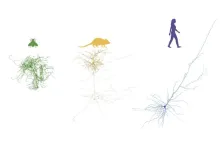(Press-News.org) CAMBRIDGE, MA – Imagine a portable 3D printer you could hold in the palm of your hand. The tiny device could enable a user to rapidly create customized, low-cost objects on the go, like a fastener to repair a wobbly bicycle wheel or a component for a critical medical operation.
Researchers from MIT and the University of Texas at Austin took a major step toward making this idea a reality by demonstrating the first chip-based 3D printer. Their proof-of-concept device consists of a single, millimeter-scale photonic chip that emits reconfigurable beams of light into a well of resin that cures into a solid shape when light strikes it.
The prototype chip has no moving parts, instead relying on an array of tiny optical antennas to steer a beam of light. The beam projects up into a liquid resin that has been designed to rapidly cure when exposed to the beam’s wavelength of visible light.
By combining silicon photonics and photochemistry, the interdisciplinary research team was able to demonstrate a chip that can steer light beams to 3D print arbitrary two-dimensional patterns, including the letters M-I-T. Shapes can be fully formed in a matter of seconds.
In the long run, they envision a system where a photonic chip sits at the bottom of a well of resin and emits a 3D hologram of visible light, rapidly curing an entire object in a single step.
This type of portable 3D printer could have many applications, such as enabling clinicians to create tailor-made medical device components or allowing engineers to make rapid prototypes at a job site.
“This system is completely rethinking what a 3D printer is. It is no longer a big box sitting on a bench in a lab creating objects, but something that is handheld and portable. It is exciting to think about the new applications that could come out of this and how the field of 3D printing could change,” says senior author Jelena Notaros, the Robert J. Shillman Career Development Professor in Electrical Engineering and Computer Science (EECS), and a member of the Research Laboratory of Electronics.
Joining Notaros on the paper are Sabrina Corsetti, lead author and EECS graduate student; Milica Notaros PhD ’23; Tal Sneh, an EECS graduate student; Alex Safford, a recent graduate of the University of Texas at Austin; and Zak Page, an assistant professor in the Department of Chemical Engineering at UT Austin. The research appears today in Nature Light Science and Applications.
Printing with a chip
Experts in silicon photonics, the Notaros group previously developed integrated optical-phased-array systems that steer beams of light using a series of microscale antennas fabricated on a chip using semiconductor manufacturing processes. By speeding up or delaying the optical signal on either side of the antenna array, they can move the beam of emitted light in a certain direction.
Such systems are key for lidar sensors, which map their surroundings by emitting infrared light beams that bounce off nearby objects. Recently, the group has focused on systems that emit and steer visible light for augmented-reality applications.
They wondered if such a device could be used for a chip-based 3D printer.
At about the same time they started brainstorming, the Page Group at UT Austin demonstrated specialized resins that can be rapidly cured using wavelengths of visible light for the first time. This was the missing piece that pushed the chip-based 3D printer into reality.
“With photocurable resins, it is very hard to get them to cure all the way up at infrared wavelengths, which is where integrated optical-phased-array systems were operating in the past for lidar,” Corsetti says. “Here, we are meeting in the middle between standard photochemistry and silicon photonics by using visible-light-curable resins and visible-light-emitting chips to create this chip-based 3D printer. You have this merging of two technologies into a completely new idea.”
Their prototype consists of a single photonic chip containing an array of 160-nanometer-thick optical antennas. (A sheet of paper is about 100,000 nanometers thick.) The entire chip fits onto a U.S. quarter.
When powered by an off-chip laser, the antennas emit a steerable beam of visible light into the well of photocurable resin. The chip sits below a clear slide, like those used in microscopes, which contains a shallow indentation that holds the resin. The researchers use electrical signals to nonmechanically steer the light beam, causing the resin to solidify wherever the beam strikes it.
A collaborative approach
But effectively modulating visible-wavelength light, which involves modifying its amplitude and phase, is especially tricky. One common method requires heating the chip, but this is inefficient and takes a large amount of physical space.
Instead, the researchers used liquid crystal to fashion compact modulators they integrate onto the chip. The material’s unique optical properties enable the modulators to be extremely efficient and only about 20 microns in length.
A single waveguide on the chip holds the light from the off-chip laser. Running along the waveguide are tiny taps which tap off a little bit of light to each of the antennas.
The researchers actively tune the modulators using an electric field, which reorients the liquid crystal molecules in a certain direction. In this way, they can precisely control the amplitude and phase of light being routed to the antennas.
But forming and steering the beam is only half the battle. Interfacing with a novel photocurable resin was a completely different challenge.
The Page Group at UT Austin worked closely with the Notaros Group at MIT, carefully adjusting the chemical combinations and concentrations to zero-in on a formula that provided a long shelf-life and rapid curing.
In the end, the group used their prototype to 3D print arbitrary two-dimensional shapes within seconds.
Building off this prototype, they want to move toward developing a system like the one they originally conceptualized — a chip that emits a hologram of visible light in a resin well to enable volumetric 3D printing in only one step.
“To be able to do that, we need a completely new silicon-photonics chip design. We already laid out a lot of what that final system would look like in this paper. And, now, we are excited to continue working towards this ultimate demonstration,” Jelena Notaros says.
###
This work was funded, in part, by the U.S. National Science Foundation, the U.S. Defense Advanced Research Projects Agency, the Robert A. Welch Foundation, the MIT Rolf G. Locher Endowed Fellowship, and the MIT Frederick and Barbara Cronin Fellowship.
END
Researchers demonstrate the first chip-based 3D printer
Smaller than a coin, this optical device could enable rapid prototyping on the go
2024-06-10
ELSE PRESS RELEASES FROM THIS DATE:
Making remanufacturing profitable
2024-06-10
Returning end-of-life products to as-new condition is called remanufacturing and can be an essential element in a circular economy. But for more industrial companies to take an interest in it, remanufacturing needs to be economically viable. In a doctoral thesis from Linköping University, Johan Vogt Duberg has investigated how this can be accomplished.
“It’s possible to take advantage of increased environmental awareness to gain economic benefits. With remanufacturing, the costs of raw materials can be reduced, new customer groups found and ...
NSF awards additional $9.8 Million for Delta, DeltaAI
2024-06-10
The National Center for Supercomputing Applications was recently awarded $4.9 million of supplemental funding from the U.S. National Science Foundation (NSF) for Delta and an additional $4.9 million for DeltaAI to expand the potential capabilities of the soon-to-launch system by nearly 50 percent.
NCSA originally received nearly $25 million from NSF in 2023 to deploy and operate DeltaAI, an advanced computing and data resource that will be a companion system to Delta. DeltaAI will triple NCSA’s AI-focused computing capacity and ...
Breakthrough in creating cyclic peptide opens the way for new antibiotics
2024-06-10
A discovery made by scientists at King’s College London could speed up efforts to produce new antibiotics in the fight against antimicrobial resistance.
In a paper published in the Journal of the American Chemical Society, scientists from the Department of Chemistry share a new, rapid method for making cyclic peptides – an important class of antibiotic molecules. The approach takes minutes rather than the hours or days it normally takes, helping overcome a major challenge in antibiotic development.
Lead author Dr Sarah Barry, from the Department of Chemistry at King’s College London, ...
Unregulated sales of a toxic and hallucinogenic mushroom endanger public health
2024-06-10
Americans’ interest in a potentially harmful “magic mushroom” is soaring, with Google searches skyrocketing 114 percent from 2022 to 2023, according to a new study by researchers at the University of California San Diego Herbert Wertheim School of Public Health and Human Longevity Science. In a paper published in the American Journal of Preventive Medicine, the scientists suggest that the growing market for Amanita muscaria may be sparked in part by emerging clinical research supporting the safety and efficacy of psilocybin as a treatment ...
Alarming trends call for action to define the future role of food in nation’s health
2024-06-10
CHICAGO, June 10, 2024 — The cost of nutritious food and the lack of access to it are of significant concern to U.S. consumers. That’s according to a new national poll of public attitudes on food and nutrition conducted by Zogby Analytics on behalf of Research!America and the American Heart Association. Nearly 7 in 10 (68%) respondents recognize healthy eating habits as an important factor in improving a person’s chance for a long and healthy life. Yet more than half (53%) say the United ...
Case studies show how quasi-governmental organizations could strengthen climate adaptation governance
2024-06-10
The politicization of climate issues and the unsynchronized efforts of stakeholders are hindering the effectiveness of climate adaptation governance in the U.S. According to a new study(Link is external) published by Princeton researchers, the design characteristics of quasi-governmental organizations (QGOs) could provide insights on how to depoliticize climate information sources and foster multi-level stakeholder coordination.
Quasi-governmental organizations are entities that have a combination of public and private characteristics, utilizing both for-profit and not-for-profit ...
Brain’s structure hangs in ‘a delicate balance’
2024-06-10
When a magnet is heated up, it reaches a critical point where it loses magnetization. Called “criticality,” this point of high complexity is reached when a physical object is transitioning smoothly from one phase into the next.
Now, a new Northwestern University study has discovered that the brain’s structural features reside in the vicinity of a similar critical point — either at or close to a structural phase transition. Surprisingly, these results are consistent across brains from humans, mice and fruit flies, which suggests the finding might be universal.
Although the researchers don’t ...
Protein study could help researchers develop new antibiotics
2024-06-10
A bacterial enzyme called histidine kinase is a promising target for new classes of antibiotics. However, it has been difficult to develop drugs that target this enzyme, because it is a “hydrophobic” protein that loses its structure once removed from its normal location in the cell membrane.
Now, an MIT-led team has found a way to make the enzyme water-soluble, which could make it possible to rapidly screen potential drugs that might interfere with its functions.
The researchers created their new version ...
Two can play that game: juvenile dolphins who play together are more successful as adults
2024-06-10
Juvenile social play predicts adult reproductive success in male bottlenose dolphins, a new study has found.
Fresh findings published today in Proceedings of the National Academy of Sciences led by researchers from the University of Bristol and University of Western Australia, show that juvenile male dolphins with strong social bonds practice adult-like reproductive behaviours when playing together, and those juvenile males who spend more time practicing will father more offspring as adults. The study provides rare evidence for a link between juvenile social play and reproductive success in a wild animal.
In collaboration with international colleagues, the ...
Wire-cut forensic examinations currently too unreliable for court, new study says
2024-06-10
A research article published June 10 in the Proceedings of the National Academy of Sciences highlights the importance of careful application of high-tech forensic science to avoid wrongful convictions.
In a study with implications for an array of forensic examinations that rely on “vast databases and efficient algorithms,” researchers found the odds of a false match significantly increase when examiners make millions of comparisons in a quest to match wires found at a crime scene with the tools allegedly used to cut them.
The rate of mistaken identifications could be as high as one in 10 or more, concluded ...
LAST 30 PRESS RELEASES:
The Ceramic Society of Japan’s Oxoate Ceramics Research Association launches new international book project
Heart-brain connection: international study reveals the role of the vagus nerve in keeping the heart young
Researchers identify Rb1 as a predictive biomarker for a new therapeutic strategy in some breast cancers
Survey reveals ethical gaps slowing AI adoption in pediatric surgery
Stimulant ADHD medications work differently than thought
AI overestimates how smart people are, according to HSE economists
HSE researchers create genome-wide map of quadruplexes
Scientists boost cell "powerhouses" to burn more calories
Automatic label checking: The missing step in making reliable medical AI
Low daily alcohol intake linked to 50% heightened mouth cancer risk in India
American Meteorological Society announces Rick Spinrad as 2026 President-Elect
Biomass-based carbon capture spotlighted in newly released global climate webinar recording
Illuminating invisible nano pollutants: advanced bioimaging tracks the full journey of emerging nanoscale contaminants in living systems
How does age affect recovery from spinal cord injury?
Novel AI tool offers prognosis for patients with head and neck cancer
Fathers’ microplastic exposure tied to their children’s metabolic problems
Research validates laboratory model for studying high-grade serous ovarian cancer
SIR 2026 delivers transformative breakthroughs in minimally invasive medicine to improve patient care
Stem Cell Reports most downloaded papers of 2025 highlight the breadth and impact of stem cell research
Oxford-led study estimates NHS spends around 3% of its primary and secondary care budget on the health impacts of heat and cold in England
A researcher’s long quest leads to a smart composite breakthrough
Urban wild bees act as “microbial sensors” of city health.
New study finds where you live affects recovery after a hip fracture
Forecasting the impact of fully automated vehicle adoption on US road traffic injuries
Alcohol-related hospitalizations from 2016 to 2022
Semaglutide and hospitalizations in patients with obesity and established cardiovascular disease
Researchers ‘listen in’ to embryo-mother interactions during implantation using a culture system replicating the womb lining
How changing your diet could help save the world
How to make AI truly scalable and reliable for real-time traffic assignment?
Beyond fragmented markets: A new framework for efficient and stable ride-pooling
[Press-News.org] Researchers demonstrate the first chip-based 3D printerSmaller than a coin, this optical device could enable rapid prototyping on the go


